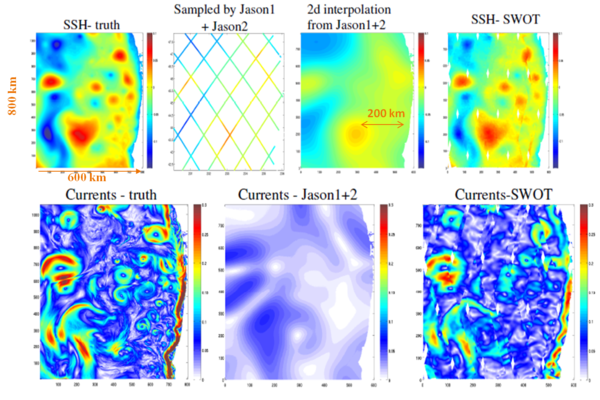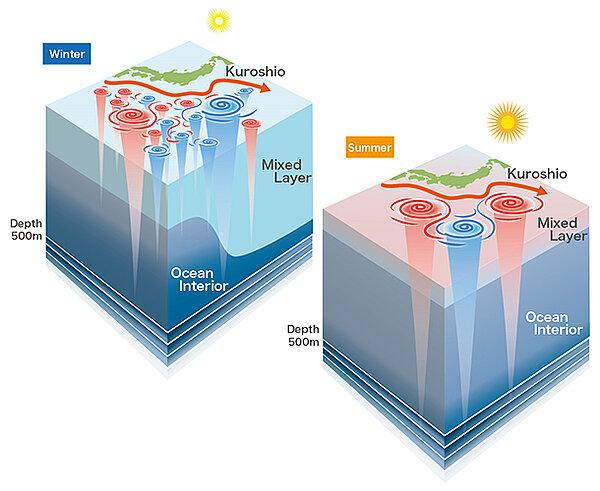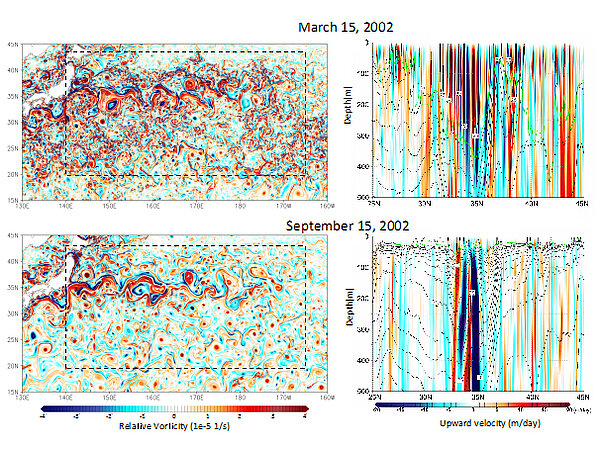Sub-mesoscale circulation
A number of processes in the ocean occur at a size of less than 50-100 km, especially vertical mixing. However, classical altimetry is "only" able to observe the larger "mesoscale" features, around 200 km in size. With a 2D observation capability, and a much higher resolution and vertical precision, Swot provides a better observation of these finer-scale processes.
Surface submesoscale circulation
Studies of the circulation at scales between 10 and 300 km are essential for quantifying the kinetic energy of ocean circulation. Traditional altimeters have revealed the fundamental role of mesoscale eddies in the horizontal transport of ocean energy, heat, carbon and nutrients. However, an important part of the circulation is happening within structures less than 200 km wide, and without capturing it a large part of the kinetic energy in the ocean is missed.
The Swot mission provides new opportunities to study directly the global mesoscale eddy field and the dynamics controlling the evolution of eddy structures, which is essential for an understanding of mesoscale eddy transports and fluxes. Swot swath measurements provide a global two-dimensional sea-surface-height fields with a 15-km spatial resolution. This enables us to resolve the full range of spatial scales of the large and small eddy field.

Seasonal variations
Studies conducted by the Swot Science Definition Team showed that seasonal variations in the submesoscale features are very important. At mid-latitudes, the submesoscale circulation is much more energetic in winter, when the ocean’s surface mixed layer is much deeper than in Summer. On the other hand, classical altimetry measurements have a higher noise in winter (due to higher waves) than in summer. The improvement in the Swot data accuracy (with noise reduced by an order of magnitude compared to classical altimetry) is enough so that winter submesoscale circulation is well observed by Swot.

Vertical currents and mixing
Most of the vertical currents and mixing in the ocean (i.e. the fact that surface waters sink in some regions, or deeper waters are upwelling to the surface or sub-surface) are occuring in fronts of around 10 to 50 km in size over the upper 300 m. This mixing is of foremost importance to understand the vertical heat, freshwater and carbon exchanges, all of which having an importance in climate studies. Today, we only have a limited understanding of these processes and mainly through high-resolution models. Swot do not measure the vertical velocities directly, but the finer-scale surface heights and currents, combined with vertical projection techniques (via analytical or numerical models). It is thus opening a whole new field of studies of vertical velocities using satellite data.

More information
- White paper : Mesoscale/sub-mesoscale dynamics in the upper ocean (pdf)
- Lee-Lueng Fu and Clement Ubelmann, 2014: On the Transition from Profile Altimeter to Swath Altimeter for Observing Global Ocean Surface Topography. J. Atmos. Oceanic Technol., 31, 560–568, doi: dx.doi.org/10.1175/JTECH-D-13-00109.1
- Qiu, B., 2015: Reconstructability of 3-Dimensional Upper Ocean Circulation from SWOT Sea Surface Height Measurements, submitted to JPO
- Sasaki Hideharu, Klein Patrice, Qiu Bo, Sasai Yoshikazu, 2014: Impact of oceanic-scale interactions on the seasonal modulation of ocean dynamics by the atmosphere. Nature Communications, 5, 1-8. doi: dx.doi.org/10.1038/ncomms6636




